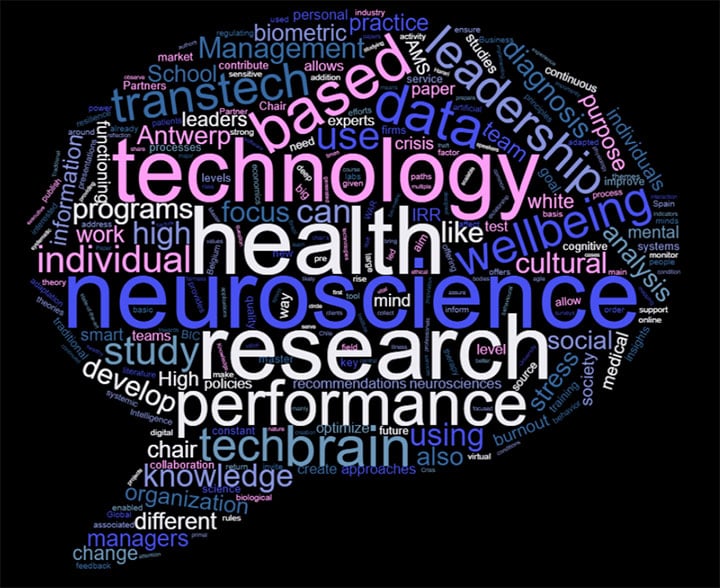
We’ve gotten rid of our tails, but not our emotions. With that statement Dr. Steven Poelmans, professor at Antwerp Management School and EADA Business School, started the Leadership Lab “inside a leader’s brain”. How come emotions have survived all these years? The limbic system takes control over the neocortex in case of a threat and we get a fight, flight or freeze reaction. It’s a matter of survival. But these primitive reflexes can also be counterproductive – especially as a leader.
30 years ago Poelmans embarked on a cross-cultural journey going by train from Brussels to Beijing. Since then he got fascinated with the universal laws across cultures. ‘We all have a brain’ is one of them. In his most recent research he attempts to utilize his knowledge of the brain to strengthen (self)leadership. “By jumping into the world of neuroscience I have started to view things in a different light”, he told us. Poelmans founded 6 NeuroTrainingLabTMs in 3 continents to try and unlock the power of the brain, generate neurofeedback and support leaders in their development. We were treated to a refreshing new view on leadership and leadership development. Right at the start Poelmans pressed us that neuroscience has a lot to tell us about emotions and that it’s not solely about cognitive processes.
Good automatisms
Did you know that the brain uses 25% of our total energy? And that 50% of that goes to the prefrontal cortex? That’s the part of the brain in charge of our most refined products, analyses and decision making. This explains why you can be so tired after a day of cognitive exercise. Just like a well-oiled production environment where operational excellence is key, our brains are obsessed with energy preservation. It stores conscious processes and automates them so that activities use up less energy. As a leader it’s very important to carefully handle this process of automatization to create “good” automatisms. And if you have some “bad” habits, mindfulness can help with determining whether or not certain habits are good for you.
Seesaw principle
This striving for energy preservation also expresses itself in the ‘seesaw-principle’. When blood flows to a certain part of our brain, it’s always at the expense of other parts. This means we CANNOT do two things at the same time (unless one of those activities is running on auto-pilot), think two thoughts at once or process different emotions in the same moment. This ‘seesaw-principle’ can also be beneficial: if you’re overwhelmed by emotions, you can start labeling them. Give them a name: fear, panic, anger, sadness, etc. This cognitive action utilizes the prefrontal cortex – and when the blood flows to there, the limbic system (in charge of our emotions) is being relieved.
Self-control
After talking about the ‘seesaw-principle’, everybody was listening with baited breath. Poelmans took a glass of water that was filled to the brim. Water spilled with every little movement. And now there was a clear image of self-control burned on our retinas. Each morning, we start the day with a healthy dose of self-control – the glass is full – but it goes down with every little annoyance. For most of us it starts in the morning with very little things: you need to use the bathroom but one of your children is in the middle of a long shower. The glass shakes and water gets spilled. You come downstairs and you find that there’s no more butter. Again the glass shakes and a bit of water spills. It’s like this all day long. No wonder you come home at night with an empty glass and you fly off the handle at the tiniest frustration. Therefore it’s very important to replenish your amount of self-control regularly, through sport, meditation or empathy.
This is only a first look at the multitude of insights that neuroscience has provided us with. It’s these insights about cognitive and emotional regulation that Poelmans integrates in the so-called NeuroTrainingLabTM, a methodology of leadership development where they observe leadership qualities as well as measure neurophysiological indicators as two participants work together with a skilled actor on a challenging business case. The (neuro)feedback gathered from this turns out to be highly effective at raising leaders’ EQ, well-being and performance.
Dealing with paradoxes
Poelmans and his colleagues noticed a rise of 32% in leadership qualities that were measured and developed in this way. And with every lab they gather more and more insights into the brain of a leader. They found that leaders who handle paradoxes better, turned out more effective. The four paradoxes they established in their research are: speaking vs listening, task vs emotional connection, control vs delegation and organization vs employee. From a neurocognitive point of view, we know that these paradoxical behaviors can’t be activated at the same time (cfr. seesaw-principle). For example, you can’t speak and listen at the same time. Even though both are important and complementary.
Switching cost
In the lab, Poelmans found that effective leaders can switch faster between this set of behaviors and related parts of the brain, in other words, they have a lower ‘switching cost’. Even more importantly, he found that effectively handling these paradoxes can be taught by making leaders aware of the importance of both sides of the paradox, giving them neurofeedback about the side they primarily rely on, and training specific behaviors that represent the other side.
What’s most refreshing and renewing about this method is that leaders – after having gone through a neurolab – not only get a clear view of their behavior but also of the neurocognitive activity underlying their leadership qualities. Do you wish to know your ‘switching cost’? A NeuroTrainingLabTM will be established in our new campus.



